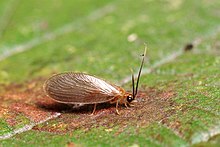Sisyridae
| Sisyridae Temporal range: Cenomanian–Recent |
|
|---|---|
 |
|
| Sisyra terminalis imago | |
| Scientific classification | |
| Kingdom: | Animalia |
| Phylum: | Arthropoda |
| Class: | Insecta |
| Order: | Neuroptera |
| Family: |
Sisyridae Banks, 1905 |
| Subfamilies | |
|
|
Sisyridae, commonly known as spongeflies or spongillaflies, are a family of winged insects in the order Neuroptera. There are approximately 60 living species described, and several extinct species identified from the fossil record.
In general appearance, the adults resemble some brown lacewings (Hemerobiidae). The forewings of spongillaflies have a span of 4–10 millimetres. The greyish or brownish wings have few cross veins except in the costal field, and most of these are not forked. The subcostal (Sc) and radial (R1) veins are fused near the wingtip.
The larvae of spongillaflies look rather bizarre. Similar to those of some osmylids (Osmylidae) at the first glance, they have spindly legs on a bulky thorax, long antennae, and flexible, threadlike mouthparts. However, the second and third instars carry seven pairs of jointed, movable tracheal gills beneath their plump abdomen. These gills are possessed by no other extant insect family, and readily distinguish them from osmylid larvae.
Adult spongillaflies are crepuscular or nocturnal. They are omnivores, sometimes hunting small invertebrates, but mainly scavenging on such animals' carcasses, as well as on pollen and honeydew.
...
Wikipedia
